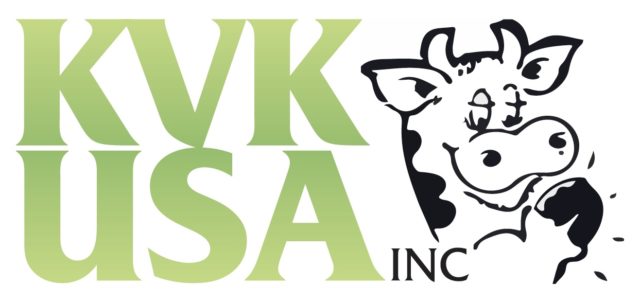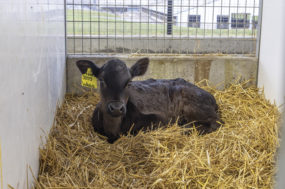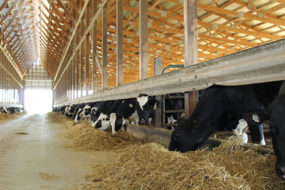Many small and mid-sized dairy operations need to upgrade their milkhouse wastewater systems. Producers want systems that perform reliably, meet environmental regulations, fit their management practices and are economical to install and operate. This [article] reviews some of the available options.
Milkhouse effluent characteristics
Typical effluent from a dairy milkhouse consists of residual milk (from the milking system and bulk tank), water, soap and acid from washing the milking system, manure, lime and other materials from the milkhouse floor that get washed down the drain. The chemical and organic makeup of milkhouse effluent is quite variable over the course of a day, but average biological oxygen demand (BOD) concentration samples leaving a primary septic tank are approximately 1,500 milligrams per liter. Total nitrogen and total phosphorus concentrations both averaged 55 milligrams per liter (0.45 pounds per 1,000 gallons).
Water flow rates varied from farm to farm. Average flow is approximately 5 gallons per cow per day. This flow or concentration data does not include effluent from cleaning of milking parlors.
Treatment system overview
All milkhouse treatment systems described here begin with a septic tank sized to hold three to four days’ worth of milkhouse effluent. This first tank removes the lime, grit and dirt from the effluent, along with some of the milk fat which accumulates on the surface of the septic tank.
These tanks are generally pumped on an annual basis. After the first septic tank, the effluent flows (via gravity or pumping) to a second septic tank or treatment unit for additional treatment. The effluent is then sent to a soil infiltration system, where it receives further polishing by the natural filtration properties and biological communities in the soil.
Waste milk
These systems are not designed to treat waste milk from treated or fresh cows. Adding waste milk into the system will overload the treatment system with organic material, and the system will fail. As a result, waste milk should be handled with the manure. Alternative systems for handling this waste milk along with parlor washwater are currently being evaluated.
Bark beds
Bark beds are flat soil infiltration areas covered with 18 to 24 inches of bark or wood shreds. A pressurized dosing system with gravel or “chambers” are used to ensure good effluent distribution over the soil infiltration area. The bark or wood shreds enhance aerobic activity, protect the infiltration area and provide wicking for additional moisture removal. This design includes a second septic tank and effluent filter to reduce organic loading to the bark bed.
The oil infiltration area is sized on the amount and strength of the effluent and site-specific soil characteristics. Typically this infiltration area is about 30 to 60 square feet per cow. Typical costs for these systems are $6,000 to $7,500.
Effluent treatment to soil infiltration
These systems are based on effluent treatment to reduce the organic loading of the effluent from the 1,500 milligrams per liter five-day biological oxygen demand (BOD5) (typical effluent from the first septic tank) to 200 milligrams per liter BOD5 (similar organic loading found with household septic tank effluent).
This treatment can be an aeration system, a biological filter system or chemical precipitation (lime flocculator). After treatment, the effluent is distributed by gravity or pressure to a standard soil infiltration area. The infiltration area is sized on the amount and strength of the effluent and site-specific soil characteristics. Soil infiltration areas typically require 10 to 15 square feet per cow. Cost of these systems have ranged between $12,000 and $15,000.
Irrigation
Irrigation systems are designed to spread the milkhouse effluent on the soil surface at agronomic rates. The system is designed with two or more irrigation zones specific for summer or winter operation. These zones are controlled manually with gate valves. The effluent is applied through the system once per day. Winter application is through the use of WobblerTM heads, and summer application is through standard impact heads. These systems require approximately 300 square feet per cow, and the cost of the system ranges from $6,000 to $7,500.
Management and system selection
All systems require pumping the septic tanks once per year along with other system-specific management, operation and maintenance. The selection of the best treatment system for a given site is a function of many factors, including land availability, topography, soil characteristics and personal preference. PD
References omitted due to space but are available upon request.
—From 2006 University of Minnesota Dairy Days Proceedings
Kevin Janni, Biosystems and Agricultural Engineering Department, University of Minnesota





